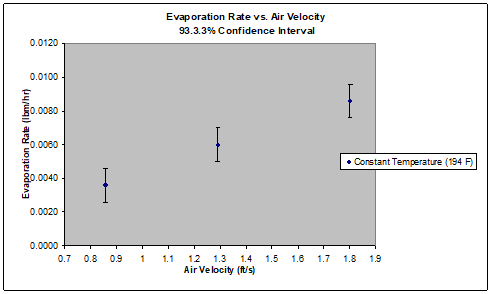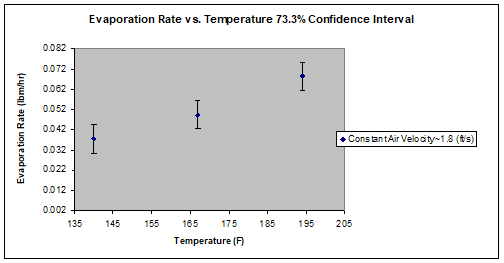トレイを使用して対流および伝導性の熱伝達を調査するドライヤー
English
Condividere
Panoramica
ソース: マイケル g. ベントンとケリー ・ m ・ ドゥーリー、工業化学科、ルイジアナ州立大学、バトン ルージュ, ルイジアナ
乾燥機は、多数の工業プロセスに使用されています。乾燥機の機能は、乾燥固形食品に熱伝達プロセスを使用することです。さまざまな種類の乾燥機が存在します。断熱乾燥機使用対流と直接接触ガス、固形物を乾燥するのに、非断熱乾燥機1伝導、放射、乾燥1無線周波数などを乾燥加熱ガス接触以外の方法を使用します。バッチ プロセスにおける乾燥機を使用ことができます。 または彼らは連続使用1になります。
この実験では、静置式乾燥機を使用して砂の乾燥速度に及ぼす温度と空気の速度が決定されます。六つのデータ セットの合計を提供する、2 つの異なる空気流量の 3 つの異なる電源設定 (1000 W、1500 W、2500 W) がテストされます。このデータから、熱・物質移動係数を計算できます。
Principi
Procedura
Risultati
From the data collected, the following information can be obtained. Use psychrometric charts to determine the absolute humidity, which gives the concentration of water present in the air. The heat transfer coefficients can be calculated using the measured temperatures and Equation 1. And finally, the change in mass of the wet sand can be used to calculate the concentration of water in the sand.
The moisture content of sand decreased linearly over time. As expected, the evaporation rate was found to increase with larger flow rate and heat duty. According to their equations, both heat and mass transfer coefficients are directly proportional to the evaporation rate at the sand-air interface. Theoretical values of heat and mass transfer coefficients were found to have a strong positive correlation with a R2 of 99%. The experimental values only showed a weak correlation after testing.
The relationships between air flow and evaporation rate and between temperature and evaporation rate both increased linearly (Figure 1, Figure 2). Increased air flow (Figure 1) and increased temperature (Figure 2) both increased the evaporation rate. These graphs show that when air flow or temperature increase and the other variable is held constant, the evaporation rate will increase at an equivalent rate and follow a positive linear trend. The air flow variation test was a measure of convective heat transfer, while the temperature variation test was a measure of conductive heat transfer. The sum of the two tests shows that both convective and conductive heat transfer follow a linear relationship with evaporation rate.

Figure 1: Depiction of the relationship between air velocity and evaporation rate, which increased linearly.

Figure 2: Depiction of the relationship between temperature and evaporation rate, which increased linearly.
There are many sources of error in the measurements with the greatest sources for error being the relative humidity and temperature of the air-sand interface. Also, the air velocity effect on the weight of the tray was deemed unimportant but it is a source of error. Some of this error may have also reduced the correlation of the heat and mass transfer coefficients. These coefficients were calculated theoretically and proven to be correlated. However, the experimental data did not show a significant trend, despite being theoretically similar.
Applications and Summary
A tray dryer was used to measure the drying rate of sand with respect to convective and conductive heat transfer. Using the dryer at three different power levels and two different flow rates, six experimental data sets were found. Measurements were taken by weighing the sand/water mixture at five minute intervals.
This experiment made use of Newton’s Law of Heating, drying rate modeling, and heat and mass transfer modeling. Heat and mass transfer coefficients were determined with the use of a boundary layer model. Theoretically, the heat and mass transfer coefficients show a very strong positive linear correlation. Even though the experimental results showed a positive trend as well, the data was too inaccurate to display any significant correlation between the two.
Tray-drying can be used in a variety of fields. One such field is pharmaceuticals. In pharmaceuticals, tray dryers are used to dry many different base materials, including sticky, granular, and crystalline materials2. Many plastics used in pharmaceuticals can be dried in tray dryers2. Additionally, precipitates, pastes, and other wet masses can be dried with a tray dryer, along with crude drugs, chemicals, powders, and tablet granules. Even some equipment is dried in the dryers2. Tray dryers offer many advantages to this industry, since they are used for batches, which can vary in size and be handled without losses2. The dryers are also readily adjusted to accompany other materials in an efficient manner2. In some cases, tray dryers in a vacuum are used to dry heat sensitive products like vitamins2.
Tray dryers are also used in food processing3. Food can be spread out thinly and evenly onto the trays for drying3. Depending on the type of food, drying can be performed by heating with air moving across the trays, conduction from heated trays or shelves, or radiation form other heated surfaces3. Air can be used with the additional benefit of removing moist vapors, though this can be a problem for some foods3.
Riferimenti
- "Solids Drying: Basics and Applications – Chemical Engineering." Chemical Engineering Solids Drying Basics and Applications Comments. N.p., n.d. Web. 12 Jan. 2017.
- "Pharmainfo.net." Tray dryer by Saraswathi.B. N.p., n.d. Web. 12 Jan. 2017.
- "Unit Operations in Food Processing – R. L. Earle." Unit Operations in Food Processing – R. L. Earle. N.p., n.d. Web. 12 Jan. 2017.
Trascrizione
Tray drying is a convective heat and mass transfer process commonly used in the industry to separate solids from liquids. In tray drying, a stream of hot gas is passed over a damp solid to vaporize the liquid. The process requires no agitation and allows for control over temperature and other properties. The flexibility of tray drying allows it to be used in chemical, pharmaceutical, and food production prior to packaging. Although seemingly simple, the process generally requires thorough experimentation to optimize drying conditions without damaging the solid. This video will illustrate how a tray dryer works, demonstrate a typical procedure for drying trials, and discuss some applications.
To start, let’s look at the operation of a tray dryer. The most basic design employs a rectangular metal frame consisting of an air inlet, ventilators, heaters, a tray compartment, and an outlet. The wet solid is loaded into a shallow tray, which is placed in the tray compartment. The ventilators and heaters force a stream of hot gas over the tray at a carefully controlled temperature and flow rate. The liquid in the tray evaporates, and is removed from the solid. Tray drying is a batch process, meaning the addition and removal of solids from the dryer are discrete steps that cannot occur simultaneously. Its advantages over other drying methods include simplicity, and flexibility of operation, and relatively low fixed-costs. Its disadvantages include high labor costs and high energy usage, although the latter can be somewhat offset by filtering and pre-forming the solid. Now that we’ve seen some basics of how drying machinery operates, let’s look at how the separation occurs.
The separation of the liquid from the solid consists of two steps. In the first step, the gas transfers heat to the liquid through convection, causing the liquid to evaporate. The rate of heat transfer, and therefore the rate of evaporation depends on the temperature difference between the gas and the liquid and an empirically determined proportionality constant called the “convective heat transfer coefficient.” In the second step, the newly vaporized liquid is transferred away from the interface through convective mass transfer to prevent recondensation. The rate of this process depends on the difference in vapor concentration between the interface and the bulk of the gas stream. The empirical proportionality constant here is the convective mass transfer coefficient. Although the coefficients can be estimated, they are unique to the solid being dried and the geometry of the tray dryer. Furthermore, the coefficients are only valid as long as the solid surface is saturated. After the surface moisture has been significantly lowered, the drying rate will decrease as the internal movement of liquid within the solid becomes the dominant mass transfer mechanism. Now that you know the principles, let’s see the sample drying procedure.
This demonstration illustrates the drying of a sand-water slurry at various temperatures and air speeds. First, check the dryer for safety hazards and ensure the psychrometer and other measuring devices are ready for use. Prepare the slurry by mixing 500 grams of sand with 150 grams of water. Pour the slurry into the tray and ensure it is spread evenly. Turn on the unit, and place the tray in the drying chamber, and record the weight. Then, turn on the blower and the dryer. Set the air velocity and temperature for the trial. Each trial will last 45 minutes with measurements taken at five-minute intervals. Use a digital thermometer to measure inlet air temperature, sand temperature, and outlet air temperature. Use the psychrometer to measure the dry-bulb and wet-bulb temperatures. Finally, record the outlet airflow rate and the weight from the balance. Repeat the process for each set of settings, totaling four unique runs. When the run is complete, use psychrometric charts or similar tools to find the absolute humidity.
The evaporation rate for each trial was determined by plotting the slurry weight as a function of time. Increasing temperatures correlated positively with the conductive heat transfer rate, and thus the evaporation rate. Increasing air velocity is associated with higher rates of convective heat transfer and mass transfer, and also increases evaporation rates. There is a positive linear correlation between air temperature and evaporation rate, as well as between air flow and evaporation rate. However, the experimental correlation between the heat and mass transfer coefficients was weaker than predicted. This may be due to the relative humidity at the air-sand interface or the effect of the air velocity on the weight of the tray.
Tray drying is commonly applied in industrial applications, both in specialty chemical production and in larger scale manufacturing, where labor expenses are not too great. Tray dryers are used in the food processing industry, typically as the last manufacturing step prior to packaging. To increase evaporation rates while controlling food quality, the dryer may be outfitted with indirect drying mechanisms, such as heated trays and radio-frequency heating. The heating conditions can be altered during the drying cycle to prevent solid materials from decomposing, warping, or cracking. Tray dryers are especially useful in facilities where several different foods, prepared in varying quantities, must be dried at unique conditions of temperature and humidity. An alternate dryer design uses multi-tray trucks. In the pharmaceutical industry, trucks are used to reduce time and labor and increase product uniformity. This design uses recirculators and baffles to control airflow, avoid dead zones, and maintain consistent temperature and humidity. For sensitive chemicals, inert atmospheres are generated. Since tray drying is physically gentler than fluid-bed or rotary tumble methods, it is suitable for the drying of sticky crystalline materials such as powders and crude drugs.
You’ve just watched JoVE’s introduction to the tray dryer. You should now understand the principles of tray drying, a process for conducting tray drying experiments, and some applications. Thanks for watching.
